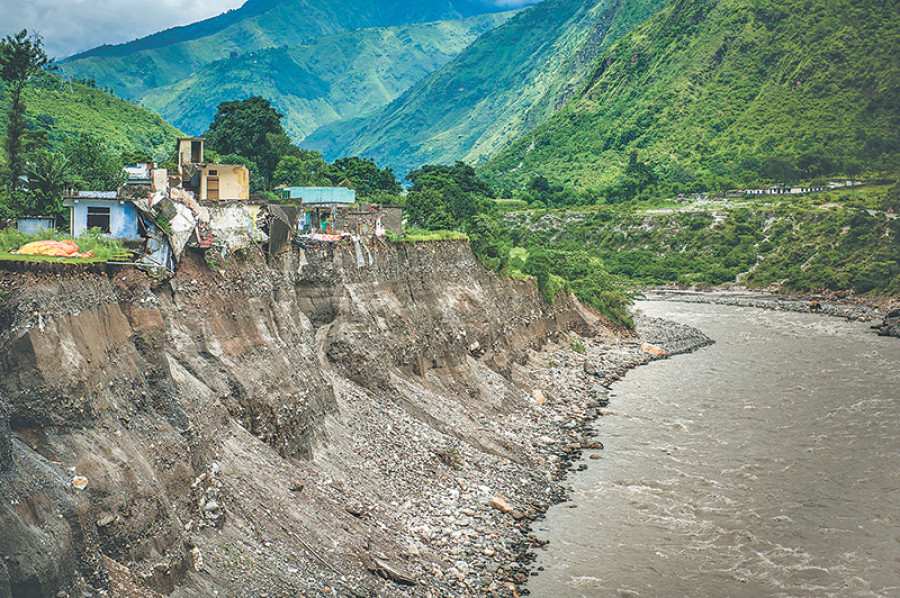Opinion
Sounding the alarm
Extreme hydrological events are on the rise, showing that the effects of climate change can be immediate and severe
Arun B Shrestha & Santosh Nepal
In recent years, the Hindu Kush Himalaya (HKH) has seen the wrath of nature numerous times. The 2010 Indus River flood in Pakistan, the 2013 Kedarnath flood in India, and the 2014 Bhote Koshi flood in Nepal left massive death and destruction in their wakes. The 2017 floods that hit Nepal, India, and Bangladesh also caused massive losses—hundreds of people died, hundreds of thousands were left homeless, and property worth millions was destroyed. In the past decade, the frequency and the intensity of extreme hydrological events in the HKH region seem to have steadily increased. The region is facing one punch after another in recent years, and now we must confront an important question: Are these events caused by climate change?
The new norm
According to a recent study in the scientific journal PLOS ONE, the answer might be “yes.” Looking at three different countries—Bhutan, Nepal and Pakistan—researchers predicted that by the end of this century, the intensity of flooding could increase by 15 to 50 percent and floods will become more frequent. The changes in flooding will be triggered by alterations in the current rainfall regime, in which high-intensity rainfall days are likely to increase by 20 to 43 percent by the end of the century.
The August 2017 floods in the Tarai and the June 2013 floods in Uttarakhand, India, provide compelling examples of disasters precipitated by atypical weather events. The former flood was caused by a positioning of a monsoon trough over the foothills of Nepal, while the Uttarakhand disaster resulted from an unusual combination of moist air flowing from the west encountering an easterly summer monsoon. Three-hundred and forty millimeters of rain fell in three days—nearly four times the average benchmark for monsoon in this area.
In the past few decades, the impact of climate change has been widely discussed while discussions regarding water resources have focused primarily on changes in water availability at a gradual, decadal scale. However, given the increasing intensity of rainfall and increasing frequency of floods, we need to turn our attention to hydro-climatic extreme events. Such disasters cause huge tolls on society in terms of human and economic loss. So it is important to understand that the impacts of climate change are not only gradual, but often immediate in the form of extreme weather events.
Extreme climatic events such as cloudbursts and intense precipitation over short periods of time can cause widespread damage in downstream areas in the form of landslides and flash floods that damage property and infrastructure. In the mountains, glacial lakes that store huge volumes of melt water behind unstable moraine dams are continuously expanding with increasing temperature. Nepal alone has 21 potentially dangerous glacial lakes that can be susceptible to outburst. Downstream communities suffer huge losses when these lakes burst their banks. Additionally, extreme events such as droughts and heat waves also impact important sectors such as agriculture.
Information and policy gap
Are we prepared for these events? Are we doing enough to understand these extreme phenomena and working to find innovative, adaptable solutions?
We should not hesitate to admit that not enough is being done in the Himalayan region. Unfortunately, scientific research is not yet a priority, and policies and plans do not take into account scientific findings.
There is dire need to invest more time and resources into understanding the science behind extreme events. We should collaborate with countries that share the Himalayan region to gather more data and information and bolster our climate science knowledge. The National Adaptation Plan (NAP), which is being prepared by the United Nations Framework Convention on Climate Change (UNFCCC) member countries, should consider extreme events along with other climate related changes when designing adaptation plans.
When it comes to understanding the future of climate extremes, there is no doubt the science is still in relative infancy, allowing for some uncertainty. However, uncertainty should not be an excuse for denial and inaction. Denying climate change can slow the momentum already generated by the tremendous efforts being made by countries worldwide to mitigate the effects of climate change. Let us act smartly so that future generations can be proud of us. Let us act responsibly before it is too late.
Nepal is a Water and Climate Specialist and Shrestha is a Senior Climate Change Specialist at the International Centre for Integrated Mountain Development (ICIMOD)




 20.12°C Kathmandu
20.12°C Kathmandu











